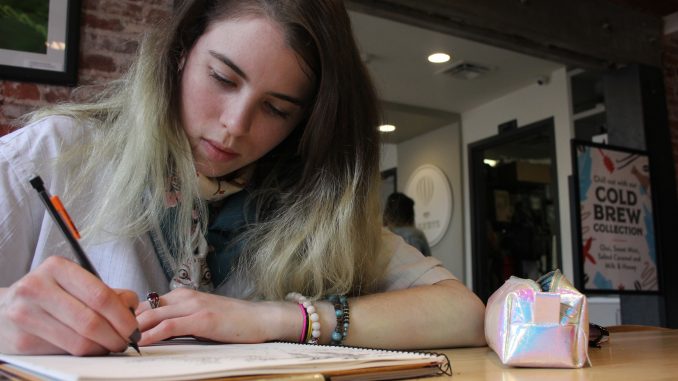
Ori Roe took a break from school in 2012 because she couldn’t decide whether to pursue science or her interests in drawing and painting.
“I was a reluctant art major,” the current senior neuroscience major said. “While I was [at Temple University Japan] studying art, I realized that it felt really empty, and I felt like I wanted something concrete.”
When Roe returned to Main Campus in Fall 2013, she decided to try studying neuroscience with a minor in art, but she found it unsustainable due to the large workloads of both fields of study.
Recently, Roe realized she wanted to learn about science through art — rather than trying to study both at the same time. Roe will pursue a master’s degree in medical or scientific illustration to combine her two passions.
In Spring 2016, Roe took foundations professor Buy Shaver’s Introduction to Visual Language class. Roe said the course taught her “how to speak with art.”
“She seemed to be searching,” Shaver said. “She was trying to figure out how to make art a part of her life and what she wanted to do.”
Shaver said he never met another student interested in scientific illustration. The Tyler School of Art doesn’t even offer courses in the subject, which is the art of drawing body parts or diagrams for scientific texts, medical professionals or researchers.
“I think Ori’s one of those special people that seems to be on a different wavelength than most of the students,” Shaver said. “We have a tendency to live our lives just trying to get by, but she’s really pushing herself to figure out where she wants to be in all of this and how she can make it work.”
One of Roe’s most recent artistic achievements is an installment in the “Saxbys Stories” campaign — which features creative work from members of each location’s community — at Saxbys on Liacouras Walk. One of Roe’s paintings was printed onto large cards which customers at the shop can take.
Last summer, while working as a computer programmer for the Neural Instrumentation Lab in the Engineering Building, Roe realized she was conflicted about which career path to follow. She decided to search for “science and art” on Google to explore options. The first result was a two-week summer science illustration program at California State University, Monterey Bay.
Coincidentally, when Roe went to California for the course, the Guild of Natural Science Illustrators held its annual conference in Santa Cruz, about a 45-minute drive from her temporary home in Monterey Bay.
Roe attended the seven-day conference, including workshops about invasive plant species, dinosaurs and infographics.
“It was there that I realized science and medical illustration is an actual career path,” Roe said. “That’s something that people don’t really talk about, but you can do it.”
Last year, Roe took Organic Chemistry with professor Steven Fleming, and said she found it fascinating. Roe’s new interest in chemistry led her to decide to work in a chemistry research lab this summer at the University of Texas at El Paso.
Fleming worked to create visual models of chemical reactions to help students who struggle to understand chemistry.
“There are many people who struggle with 3-D perception, depth perception for example, and it helps to have model sets to show people how the atoms are arranged and how bonds can rotate,” Fleming said. “If you try to represent that on chalkboard or paper or in a book, it’s pretty tough to get it.”
While working, Roe plans to continue updating her academic art portfolio, which she will eventually use when she reapplies to the medical and biological illustration master’s program at Johns Hopkins University. Roe applied to the program this year, but she was not admitted.
“I only found out about them six months ago,” Roe said. “They’re like the top medical association, so I wouldn’t have expected to get in for only having worked on my portfolio for six months.”
Although she still plans to continue to work on her portfolio as she prepares to enter the medical illustration field, Roe said she’s satisfied with the way she has chosen to merge her interests, instead of having to choose between them.
“There’s always a third option,” Roe added. “Even if it’s not a better option, even if it takes a long time to figure out what that third option is, there is always a third option.”
Meghan Costa can be reached at meghan.caroline.costa@temple.edu or on Twitter @Meg_costa19.


Be the first to comment